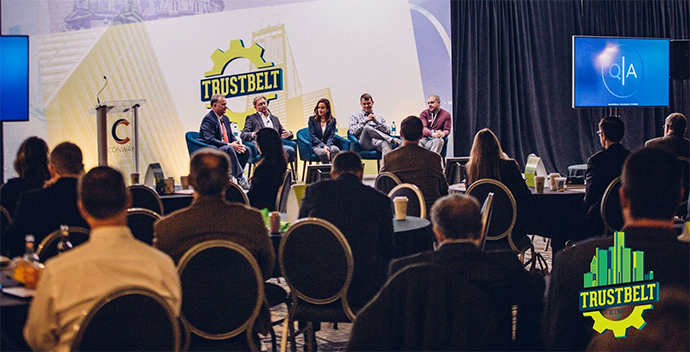If you’re tired of riding around in a boring automobile, legendary car designer Henrik Fisker has some encouraging words for you: "In the future, when we buy a car, it will be a much more emotionally exciting car. There will be no need to own a boring car."
In his talk on "shifting car cultures" at The Future of Automotive session at TrustBelt 2018 in Detroit on Nov. 6, Fisker described a world, not that far away, in which new mobility technology would not only unleash greater productivity, but also make transportation fun again.
"Autonomous vehicles will allow the older generation to be mobile again," said Fisker, chairman and CEO of Fisker Inc. "The younger generations are already getting used to adopting newer brands, and the people buying electric vehicles in the next five years will still be considered early adopters. But for a brand to be successful, it will have to be authentic in its move to EVs."
“The biggest drivers of change in the automotive industry are electrification, autonomous vehicles and connected vehicles.”
Fisker’s words came just as CBRE was releasing its in-depth report on how autonomous vehicles would alter the U.S. office market by 2030. In that report, CBRE concluded that, "By disrupting the way employees commute to work, autonomous vehicles are expected to fundamentally reshape the U.S. office market by 2030. Most significantly, the primacy of commercial real estate’s traditional decision drivers – geographic location and access to talent – may decrease as the importance on the workplace experience and building amenities grows."
The CBRE report adds that AVs "could account for between 11 and 27 percent of vehicle-miles traveled by 2030. Factors considered in CBRE’s analysis include the rate at which the cost-per-mile for AVs decreases compared to personal cars; the time it takes to develop software capable of navigating both inclement weather and complex urban roadway layouts; and advances in vehicle manufacturing capacity."
What will unlock wide-scale adoption of EVs and AVs? "Solid state battery technology," says Fisker. "Once we get the cost below $75 per kilowatt hour, that’s when battery technology will take over and replace gas- and diesel-powered automobiles. Our goal at Fisker is to have batteries in vehicles by 2020. We will not produce the batteries ourselves, but we would want them made in the USA."
Searching the USA for the Right Spot
Fisker, whose company is based in California, said he is currently scouting America for a site for a new automotive assembly plant for his Fisker Inc. car company to produce a $40,000 all-electric vehicle. "We are scouting for factory locations all over the U.S.," he said. "We have identified three potential sites."
May Russell, chief information officer of Ford Commercial Solutions for Ford Motor Co., echoed Fisker by saying that, "We recognize that car ownership is on the decline. To remain competitive and relevant, we have to become a mobility company. People are no longer interested in driving as an experience. They’re interested in getting from Point A to Point B."
Autonomous vehicles could account for between
11 and 27
percent of vehicle-miles
traveled by 2030.
Michael Fleming, founder and CEO of Torc Robotics in Blacksburg, Virginia, said the autonomous vehicle world is closer than most people think. "We are going to have self-driving shuttles in smaller environments in the near term," he said. His company has already developed the Asimov, a self-driving Lexus SUV that completed a fully autonomous, 4,300-mile cross-country trip – totally powered by Torc technology developed by Fleming and his team of researchers and engineers out of Virginia Tech.
Russell says other hurdles remain. "There must be collaboration between automotive companies and suppliers and cities. It is critical," she said. "At a minimum, we need a major deployment of charging stations. And with AVs, it is a lot more complicated. Curbside pickup and drop-off spaces need to be available in our cities if this is going to happen safely. The reality today is that our public transit system is not seamless and collaborative."
What Locations Must Do to Get Ready for AVs
The related CBRE report advises office owners and occupiers to position themselves for the future now by:
- Focusing on creating the most attractive building and work environment possible.
- Replacing parking lots, garages and on-street parking with amenities and urban retail.
- Targeting walkable areas.
- Considering a broader geographic range of opportunities for office locations or investments.
Fisker said other changes are in store and coming soon. "Electrification is coming not just to car companies, but to trucking as well," he noted. "Brands themselves are going to have to change. Brands today are based on engine sounds and look and interior. Every car brand will have to reinvent itself."
Ultimately, the designer of the iconic BMW Z8 roadster said, people will adapt. "When the time is right, and the price is right, people will adapt," he said. "You probably feel right now that the next risk is not as big as other people see it, but this is coming."

